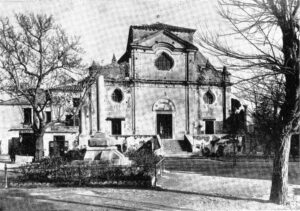MUNICIPALITY: Ravello
NAME: Villa Episcopio
LOCATION: Episcopio Street
DESCRIPTION:
Villa Episcopio, built during the 11th century, is the former residence of the bishops of Ravello. The architectural complex, consisting of several floors, with an atrium and vaulted rooms, according to the aesthetic canons of Ravello’s medieval domus, is located in the Toro district, the oldest nucleus of the town. Near the palace stood the church of St. Bartholomew, already in ruins in 1606, and the church of Tutti I Santi (All Saints), used during the 16th century as a furnace for melting bells. During the 17th century Msgr. Giuseppe Saggese began the restoration of the now dilapidated bishop’s complex, which in those years housed the diocesan seminary. The halls of the complex also housed the luncheon that until the 17th century was offered to the diocesan clergy on Holy Thursday and the ‘Assumption of the Virgin Mary, titular of the cathedral. It had to include roasted pork shoulders, seasoned with oil, cabbage and zucchini, caciocavallo cheese, salted fish, umbula (sweet bread with eggs), mostaccioli (small, spiced turbot-shaped pastries), and wine. Radical interventions were also necessary for the second half of the following century: bishop Biagio Chiarelli expanded the monumental complex, by then uninhabitable and at risk of collapse, with new rooms and adorned it with frescoes and columns. The palace, with an atrium and inner garden, also housed the episcopal curia and the so-called celendra, intended for polishing using mangle and dyeing woolen cloth, an activity practiced in the city since 1299 and ceased with the plague of 1656. At the end of the 18th century, the palace, which became the home of “madonna povertà,” housed men, women, and children, who were offered a frugal meal that constituted their only means of sustenance. In the second half of the nineteenth century Francis Nevile Reid, a Scottish botanist, and passionate art lover, acquired Villa Episcopio, and later provided for its restoration. The charm of the ancient complex and the fortuitous location induced Pasquale Palumbo, an employee of Reid, and his wife, the Bernese Elizabeth Von Wartburg, to transform the ancient Episcopio into Ravello’s first guesthouse: the “Pensione Palumbo” destined to welcome eminent personalities of art, culture, and politics. From February to June 1944, Villa Episcopio was the temporary home of Victor Emmanuel III and Queen Elena, guests of Duke Riccardo di Sangro, who had acquired the residence in 1926.
In the hall of the palace on April 22 of that year, the ministers of the First Government of National Unity, formed by representatives of the anti-fascist parties, swore an oath in the presence of the sovereign. On June 5 Victor Emmanuel III entrusted the lieutenancy of the kingdom to his son Umberto in the extraordinary surroundings of those places beloved by Wagner. An important page in the history of Italy had been written.
SEE, VISIT, FIND: under renovation
FRUITION DATA: none




